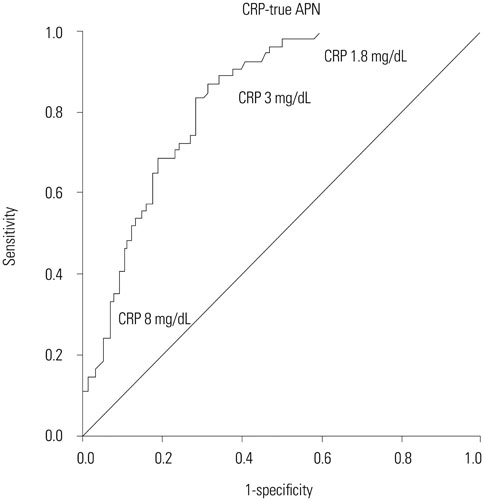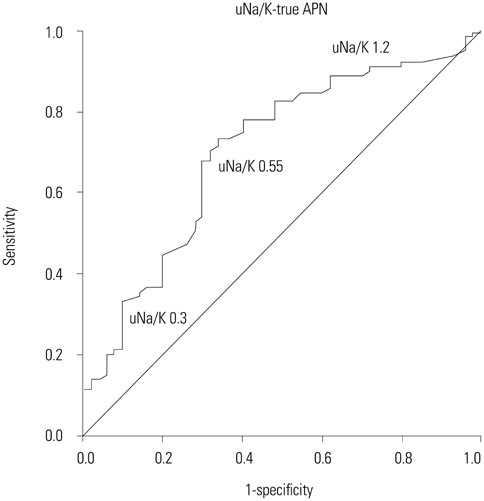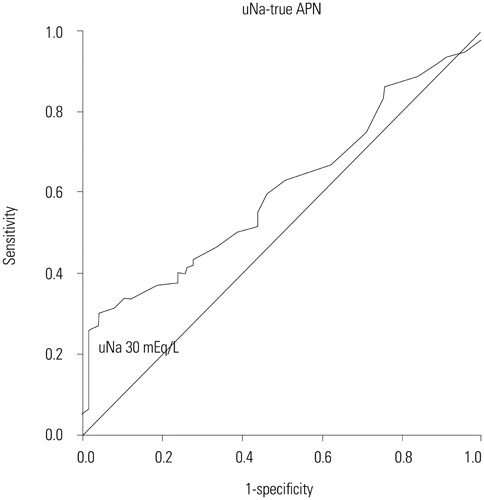Yonsei Med J.
2016 Jan;57(1):103-110. 10.3349/ymj.2016.57.1.103.
Prediction of Cortical Defect Using C-Reactive Protein and Urine Sodium to Potassium Ratio in Infants with Febrile Urinary Tract Infection
- Affiliations
-
- 1Department of Pediatrics, CHA Bundang Medical Center, CHA University, Seongnam, Korea. naesusana@gmail.com
- KMID: 2466358
- DOI: http://doi.org/10.3349/ymj.2016.57.1.103
Abstract
- PURPOSE
We investigated whether C-reactive protein (CRP) levels, urine protein-creatinine ratio (uProt/Cr), and urine electrolytes can be useful for discriminating acute pyelonephritis (APN) from other febrile illnesses or the presence of a cortical defect on 99mTc dimercaptosuccinic acid (DMSA) scanning (true APN) from its absence in infants with febrile urinary tract infection (UTI).
MATERIALS AND METHODS
We examined 150 infants experiencing their first febrile UTI and 100 controls with other febrile illnesses consecutively admitted to our hospital from January 2010 to December 2012. Blood (CRP, electrolytes, Cr) and urine tests [uProt/Cr, electrolytes, and sodium-potassium ratio (uNa/K)] were performed upon admission. All infants with UTI underwent DMSA scans during admission. All data were compared between infants with UTI and controls and between infants with or without a cortical defect on DMSA scans. Using multiple logistic regression analysis, the ability of the parameters to predict true APN was analyzed.
RESULTS
CRP levels and uProt/Cr were significantly higher in infants with true APN than in controls. uNa levels and uNa/K were significantly lower in infants with true APN than in controls. CRP levels and uNa/K were relevant factors for predicting true APN. The method using CRP levels, u-Prot/Cr, u-Na levels, and uNa/K had a sensitivity of 94%, specificity of 65%, positive predictive value of 60%, and negative predictive value of 95% for predicting true APN.
CONCLUSION
We conclude that these parameters are useful for discriminating APN from other febrile illnesses or discriminating true APN in infants with febrile UTI.
MeSH Terms
-
Acute Disease
C-Reactive Protein/*analysis
Case-Control Studies
Fever/microbiology
Humans
Infant
Male
Potassium/*urine
Predictive Value of Tests
Prospective Studies
Proteinuria/diagnosis
Pyelonephritis/*diagnosis/radionuclide imaging
Sensitivity and Specificity
Sodium/*urine
*Technetium Tc 99m Dimercaptosuccinic Acid
Urinary Tract Infections/drug therapy/microbiology/*radionuclide imaging
C-Reactive Protein
Potassium
Sodium
Technetium Tc 99m Dimercaptosuccinic Acid
Figure
Cited by 1 articles
-
Predictors of renal scars in infants with recurrent febrile urinary tract infection: a retrospective, single-center study
Jae Ha Han, Seonkyeong Rhie, Jun Ho Lee
Child Kidney Dis. 2022;26(1):52-57. doi: 10.3339/ckd.22.019.
Reference
-
1. Saadeh SA, Mattoo TK. Managing urinary tract infections. Pediatr Nephrol. 2011; 26:1967–1976.
Article2. Subcommittee on Urinary Tract Infection, Steering Committee on Quality Improvement and Management. Roberts KB. Urinary tract infection: clinical practice guideline for the diagnosis and management of the initial UTI in febrile infants and children 2 to 24 months. Pediatrics. 2011; 128:595–610.
Article3. Fernbach SK, Maizels M, Conway JJ. Ultrasound grading of hydronephrosis: introduction to the system used by the Society for Fetal Urology. Pediatr Radiol. 1993; 23:478–480.
Article4. Lebowitz RL, Olbing H, Parkkulainen KV, Smellie JM, Tamminen-MÖbius TE. International system of radiographic grading of vesicoureteric reflux. International Reflux Study in Children. Pediatr Radiol. 1985; 15:105–109.
Article5. Busch R, Huland H. Correlation of symptoms and results of direct bacterial localization in patients with urinary tract infections. J Urol. 1984; 132:282–285.
Article6. Printza N, Farmaki E, Piretzi K, Arsos G, Kollios K, Papachristou F. Acute phase 99mTc-dimercaptosuccinic acid scan in infants with first episode of febrile urinary tract infection. World J Pediatr. 2012; 8:52–56.
Article7. Siegel SR, Siegel B, Sokoloff BZ, Kanter MH. Urinary infection in infants and preschool children. Five-year follow-up. Am J Dis Child. 1980; 134:369–372.
Article8. Simerville JA, Maxted WC, Pahira JJ. Urinalysis: a comprehensive review. Am Fam Physician. 2005; 71:1153–1162.9. Jaksic E, Bogdanovic R, Artiko V, Saranovic DS, Petrasinovic Z, Petrovic M, et al. Diagnostic role of initial renal cortical scintigraphy in children with the first episode of acute pyelonephritis. Ann Nucl Med. 2011; 25:37–43.
Article10. Garin EH, Olavarria F, Araya C, Broussain M, Barrera C, Young L. Diagnostic significance of clinical and laboratory findings to localize site of urinary infection. Pediatr Nephrol. 2007; 22:1002–1006.
Article11. Ansari Gilani K, Modaresi Esfeh J, Gholamrezanezhad A, Gholami A, Mamishi S, Eftekhari M, et al. Predictors of abnormal renal cortical scintigraphy in children with first urinary tract infection: the importance of time factor. Int Urol Nephrol. 2010; 42:1041–1047.
Article12. Brewster UC, Perazella MA. The renin-angiotensin-aldosterone system and the kidney: effects on kidney disease. Am J Med. 2004; 116:263–272.
Article13. Dear PR, Newell SJ. Oxford Textbook of Clinical Nephrology. In : Davison AM, Cameron JS, Grünfeld JP, Ponticelli C, Ritz E, Winearls CG, van Ypersele C, editors. Renal function in the newborn infant. 3rd ed. New York: Oxford University Press;2005. p. 70.14. Leman P. Validity of urinalysis and microscopy for detecting urinary tract infection in the emergency department. Eur J Emerg Med. 2002; 9:141–147.
Article15. Eidelman Y, Raveh D, Yinnon AM, Ballin J, Rudensky B, Gottehrer NP. Reagent strip diagnosis of UTI in a high-risk population. Am J Emerg Med. 2002; 20:112–113.
Article16. Bagley RS, Center SA, Lewis RM, Shin S, Dougherty SA, Randolph JF, et al. The effect of experimental cystitis and iatrogenic blood contamination on the urine protein/creatine ratio in the dog. J Vet Intern Med. 1991; 5:66–70.
Article17. Schardijn G, Statius van Eps LW, Swaak AJ, Kager JC, Persijn JP. Urinary beta 2 microglobulin in upper and lower urinary-tract infections. Lancet. 1979; 1:805–807.18. Mengoli C, Lechi A, Arosio E, Rizzotti P, Lechi C, Corgnati A, et al. Contribution of four markers of tubular proteinuria in detecting upper urinary tract infections. A multivariate analysis. Nephron. 1982; 32:234–238.
Article19. Everaert K, Raes A, Hoebeke P, Samijn W, Delanghe J, Vande Wiele C, et al. Combined use of urinary alpha1-microglobulin and 99mTc DMSA scintigraphy in the diagnosis and follow-up of acute pyelonephritis and cystitis in children. Eur Urol. 1998; 34:486–491.
Article20. Jantausch BA, Rifai N, Getson P, Akram S, Majd M, Wiedermann BL. Urinary N-acetyl-beta-glucosaminidase and beta-2-microglobulin in the diagnosis of urinary tract infection in febrile infants. Pediatr Infect Dis J. 1994; 13:294–299.
Article21. Tsao CH, Huang WS, Cheng CY, Wu SL, Lin YZ, Lin MH. Evaluation of culture negative acute pyelonephritis with 99mTc-DMSA renal scan in children. Ann Nucl Med Sci. 2003; 16:117–122.22. Gil-Ruiz MA, Alcaraz AJ, MarañÓn RJ, Navarro N, Huidobro B, Luque A. Electrolyte disturbances in acute pyelonephritis. Pediatr Nephrol. 2012; 27:429–433.
Article23. DuBose T, Hamm L. Acid-base and electrolyte disorders: A companion to Brenner & Rector's The Kidney. Philadelphia: Saunders;2002.24. Earley LE, Martino JA, Friedler RM. Factors affecting sodium reabsorption by the proximal tubule as determined during blockade of distal sodium reabsorption. J Clin Invest. 1966; 45:1668–1684.
Article25. Lee JH, Kim MK, Park SE. Is a routine voiding cystourethrogram necessary in children after the first febrile urinary tract infection? Acta Paediatr. 2012; 101:e105–e109.
Article
- Full Text Links
- Actions
-
Cited
- CITED
-
- Close
- Share
- Similar articles
-
- Predictors of renal scars in infants with recurrent febrile urinary tract infection: a retrospective, single-center study
- Plasma Neutrophil Gelatinase-Associated Lipocalin as a Predictor of Renal Parenchymal Involvement in Infants With Febrile Urinary Tract Infection: A Preliminary Study
- Clinical Experiences with Febrile Infants, Younger than Three Months, with Urinary Tract Infection in a Single Center for Four Years: Incidence, Pathogens and Viral Co-infections
- Clinical Significance of Hydronephrosis in Febrile Urinary Tract Infection
- Evaluation of Random Urine Sodium and Potassium Compensated by Creatinine as Possible Alternative Markers for 24 Hours Urinary Sodium and Potassium Excretion




